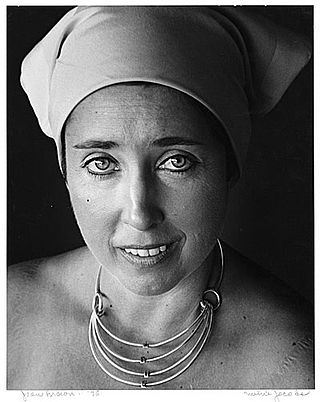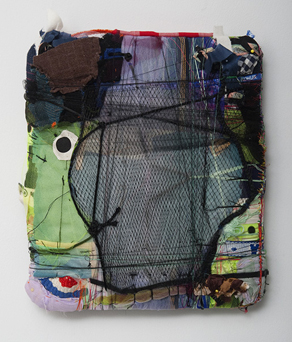Related Research Articles

Richard Diebenkorn was an American painter and printmaker. His early work is associated with abstract expressionism and the Bay Area Figurative Movement of the 1950s and 1960s. In the late 1960s he began his extensive series of geometric, lyrical abstract paintings. Known as the Ocean Park paintings, these paintings were instrumental to his achievement of worldwide acclaim. Art critic Michael Kimmelman described Diebenkorn as "one of the premier American painters of the postwar era, whose deeply lyrical abstractions evoked the shimmering light and wide-open spaces of California, where he spent virtually his entire life."

Jay DeFeo was an American visual artist who became celebrated in the 1950s as part of the spirited community of Beat artists, musicians, and poets in San Francisco. Best known for her monumental work The Rose, DeFeo produced courageously experimental works throughout her career, exhibiting what art critic Kenneth Baker called “fearlessness.”

Margaret Leisha Kilgallen was a San Francisco Bay Area artist who combined graffiti art, painting, and installation art. Though a contemporary artist, her work showed a strong influence from folk art. She was considered a central figure in the Bay Area Mission School art movement.

Joan Mitchell was an American artist who worked primarily in painting and printmaking, and also used pastel and made other works on paper. She was an active participant in the New York School of artists in the 1950s. A native of Chicago, she is associated with the American abstract expressionist movement, even though she lived in France for much of her career.
The Bay Area Figurative Movement was a mid-20th-century art movement made up of a group of artists in the San Francisco Bay Area who abandoned working in the prevailing style of Abstract Expressionism in favor of a return to figuration in painting during the 1950s and onward into the 1960s.

Joan Brown was an American figurative painter who lived and worked in Northern California. She was a member of the "second generation" of the Bay Area Figurative Movement.
Salma Arastu is an internationally exhibited woman artist known for her unique global perspective, reflecting her diverse cultural background and experiences. Born in Rajasthan, India, Aratsu pursued her formal education in Fine Arts at Maharaja Sayajirao University in Baroda, India. She was raised in the Sindhi and Hindu traditions and later embraced Islam and moved to the USA in 1986, currently residing in California. As a woman, artist, and mother, Arastu's creative endeavors aim to foster harmony and express the universality of humanity through various art forms, including paintings, sculpture, and poetry. She has also worked extensively with calligraphy and produces greeting cards for the American Muslim community.

Maxine Albro was an American painter, muralist, lithographer, mosaic artist, and sculptor. She was one of America's leading female artists, and one of the few women commissioned under the New Deal's Federal Art Project, which also employed Jackson Pollock, Mark Rothko, and Willem de Kooning.
Margaret Rinkovsky is an American landscape painter.

Julia Couzens is a California-based, American artist known for a diverse body of work that embraces unconventional materials and methods and includes drawing, sculpture, installation art, and writing. Critic David Roth identifies as a connecting thread in her evolving work, her "decidedly surrealist-symbolist sensibility, in which eroticism, the grotesque and the gothic mix in equal parts." Her work has been shown internationally and throughout the United States, including solo exhibitions at the Christopher Grimes Gallery and California State University, Stanislaus (2009), in surveys at the University of California, Davis and Sonoma Museum of Visual Art (1999), and group shows at the Crocker Art Museum, P•P•O•W, Orange County Museum of Art, Hammer Museum, and BAMPFA, among others. Her art has been reviewed in the Los Angeles Times, San Francisco Chronicle, Flash Art, New Art Examiner, and Art Practical, among other publications, and collected by institutions including the Crocker Art Museum, Fine Arts Museums of San Francisco, Oakland Museum of California and Butler Institute of American Art, among many. In addition to working as an artist, Couzens has taught at several Southern California universities and writes about contemporary art for The Sacramento Bee and Squarecylinder. She lives and works on Merritt Island in the Sacramento River delta community of Clarksburg and maintains a studio in downtown Los Angeles.

Ynez Johnston was an American painter, sculptor, printmaker, and educator. Known for her work in painting, printmaking, and mixed media, Johnston was particularly inspired by Byzantine art, as well as Tibetan, Indian, Mexican, and Nepalese art from her extensive travels. Johnston was based in the San Francisco Bay Area in early life, and moved to Los Angeles in 1949.
Léonie Guyer is a contemporary artist based in San Francisco. She makes paintings, drawings, site-based work, prints, and artist books. Her post-minimalist abstract work is characterized by idiosyncratic shapes that are deployed in a variety of spaces.

Ruth Armer was an American abstractionist painter, teacher, art collector, and lithographer, from the San Francisco Bay area in California. Her art is held in the collections of San Francisco Museum of Modern Art, and the Fine Arts Museums of San Francisco.
Augusta Payne Briggs Rathbone was an American painter, etcher and printmaker. She studied at the University of California, Berkeley and in Paris. She depicted people and locations from San Francisco, the Sierra, New York City, the West Coast of Canada, the Canadian Rockies, and France. In 1938, she published a book of aquatints of French Riviera Villages with photographs by Juliet Thompson and text by Virginia Thompson. Her work appeared internationally in group and solo exhibitions, and continues to appear in retrospectives of American printmaking.

Zoe Longfield (1924–2013) was an American abstract expressionist artist from the San Francisco Bay Area. She was among the first generation of Abstract Expressionists, which arose primarily in New York and San Francisco in the second half of the 1940s. She appears, with fellow student Frank Lobdell and others, in a 1948 photograph from the California School of Fine Arts (CSFA). During her few years of activity, Longfield produced a significant body of paintings, prints, and drawings showcasing a unique visual aesthetic.

Susan Landauer (1958–2020) was an American art historian, author, and curator of modern and contemporary art based in California. She worked for three decades, both independently and as chief curator of the San Jose Museum of Art (SJMA) and co-founder of the San Francisco Center for the Book. Landauer was known for championing movements and idioms of California art, overlooked artists of the past, women artists, and artists of color. She organized exhibitions that gained national attention; among the best known are: "The San Francisco School of Abstract Expressionism", "Visual Politics: The Art of Engagement", and retrospectives of Elmer Bischoff, Roy De Forest, and Franklin Williams. Her work was recognized with awards and grants from the International Association of Art Critics, National Endowment for the Arts and Henry Luce Foundation, among others. Critics, including Roberta Smith and Christopher Knight, praised her scholarship on San Francisco Abstract Expressionism, De Forest, Richard Diebenkorn, and Bernice Bing, among others, as pioneering. In 2021, Art in America editor and curator Michael Duncan said that "no other scholar has contributed as much to the study of California art". Landauer died of lung cancer at age 62 in Oakland on December 19, 2020.
Nancy Genn is an American artist living and working in Berkeley, California known for works in a variety of media, including paintings, bronze sculpture, printmaking, and handmade paper rooted in the Japanese washi paper making tradition. Her work explores geometric abstraction, non-objective form, and calligraphic mark making, and features light, landscape, water, and architecture motifs. She is influenced by her extensive travels, and Asian craft, aesthetics and spiritual traditions.
Sylvia Lark (1947–1990) was a Native American/Seneca artist, curator, and educator. She best known as an Abstract expressionist painter and printmaker. Lark lived in the San Francisco Bay Area for many years.

Helen Bell Bruton was an American printmaker, mosaic muralist and painter.
Lionel Thomas was a painter, muralist, designer, sculptor, printmaker and educator. He was best known for the public artworks he, often with his wife Patricia, created for architecture in Vancouver and elsewhere. He taught for almost four decades at two art schools, first at the Vancouver School of Art and then at the University of British Columbia.
References
- ↑ "The University Loyalty Oath: A 50th Anniversary Perspective Symposium - Margaret Peterson Art Exhibit". www.lib.berkeley.edu. John Douglass, Sally Thomas. Retrieved 2018-03-10.
{{cite web}}: CS1 maint: others (link) - 1 2 3 4 5 "Biography - Margaret Peterson". uvac.uvic.ca. Retrieved 2018-03-11.
- 1 2 3 4 Graham, Colin (1978). Introduction. Victoria: Art Gallery of Greater Victoria. p. 5.
- 1 2 3 "Margaret Peterson: Berkeley Modernist". womenoutwest.blogspot.ca. 23 February 2015. Retrieved 2018-03-11.
- 1 2 3 4 5 6 Peterson, Margaret (1978). Margaret Peterson--On Influences. Victoria: Art Gallery of Greater Victoria. p. 9.
- 1 2 3 4 5 6 7 8 9 10 11 12 13 14 15 16 17 18 19 20 21 22 23 "Canadian Women Artists History Initiative : Artist Database : Artists : PETERSON, Margaret". cwahi.concordia.ca. Retrieved 2018-03-11.
- ↑ "Margaret Peterson fonds - MemoryBC". www.memorybc.ca. Retrieved 2018-03-11.